Great Blue Herons can take off at a steeper angle than some might think.
Yes, I know. I’m posting the same species in back-to-back posts again. But this is a different heron, at a different place at the refuge and both the circumstances and the setting are very different from my previous post.
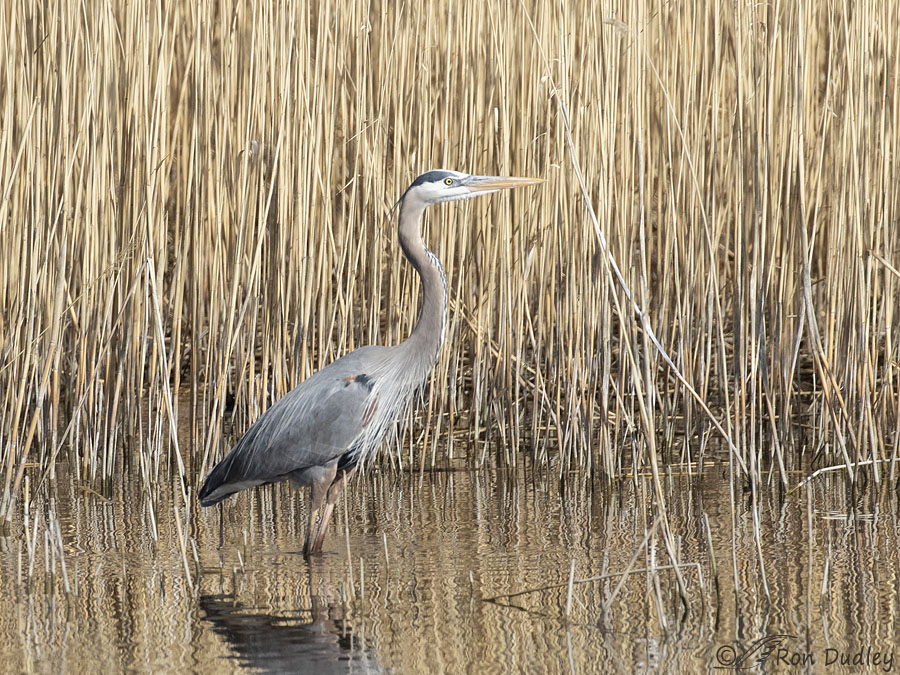
1/5000, f/6.3, ISO 800, Canon 7D Mark II, Canon EF 100-400mm f/4.5-5.6L IS II USM @ 360mm, not baited, set up or called in
Six days ago, on the same morning I photographed the Great Blue Heron I posted photos of yesterday, I found another potentially interesting Great Blue Heron at Bear River MBR. This one was closer so I had to use my smaller zoom lens to give me enough room in the frame if he took off. When I grabbed my other shooting rig I didn’t take the time to check my settings, instead I just fired away and hoped for the best. As a result my shutter speeds were very high but the photos turned out well.
Great Blue Herons are big, heavy birds with huge wings that scoop a lot of air so their flight is slow and lumbering and their takeoffs are usually at low angles – almost by necessity. So if and when this heron took off I expected him to take off at a low angle and gain elevation slowly.
But ‘he’ fooled me.
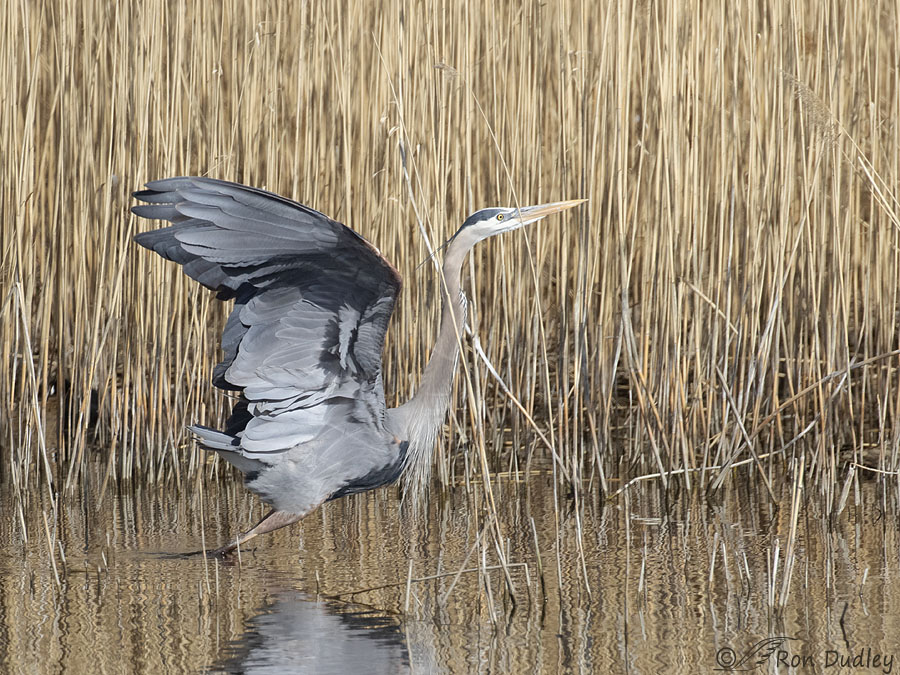
1/5000, f/6.3, ISO 800, Canon 7D Mark II, Canon EF 100-400mm f/4.5-5.6L IS II USM @ 360mm, not baited, set up or called in
He chose to take off to my right, in spite of the fact that there was an obstacle in front of him that I hadn’t noticed. In this photo the obstacle is still out of frame to the right. There are several emergent phrag stems all around his intended flight path but they’re relatively slender and small and they didn’t seem to bother him – he just threaded the needle right through them.
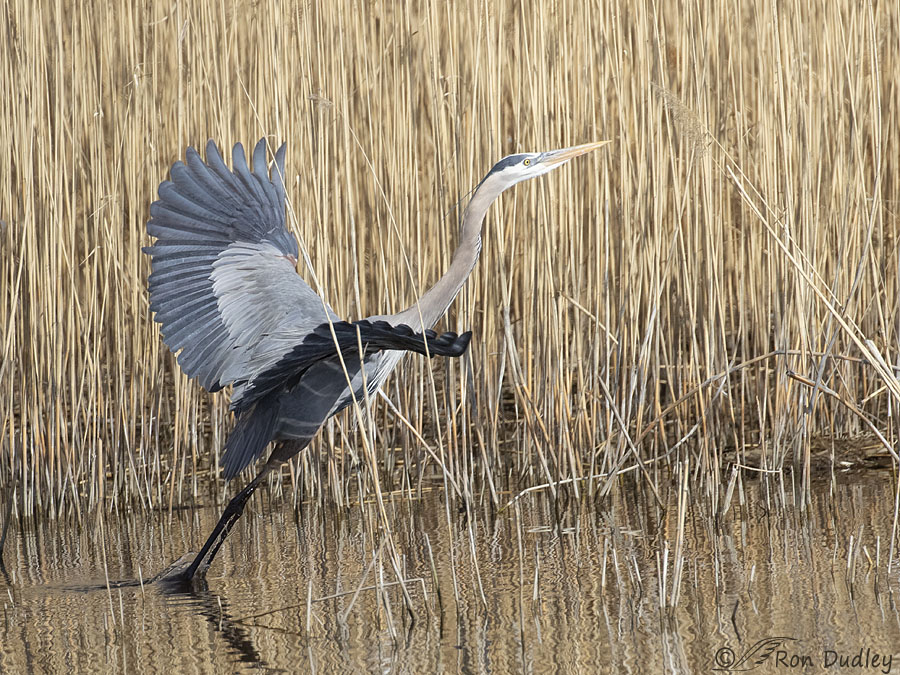
1/5000, f/6.3, ISO 800, Canon 7D Mark II, Canon EF 100-400mm f/4.5-5.6L IS II USM @ 360mm, not baited, set up or called in
But one of the stems was a more substantial obstacle that he intended to avoid. It’s leaning across his intended flight path and we’re beginning to see it at the right edge of the frame.
Notice his angle of takeoff which seems unusually steep for a Great Blue Heron. I guess I’m not surprised that they’re capable of such a steep takeoff angle but I sure don’t see it very often with this species..
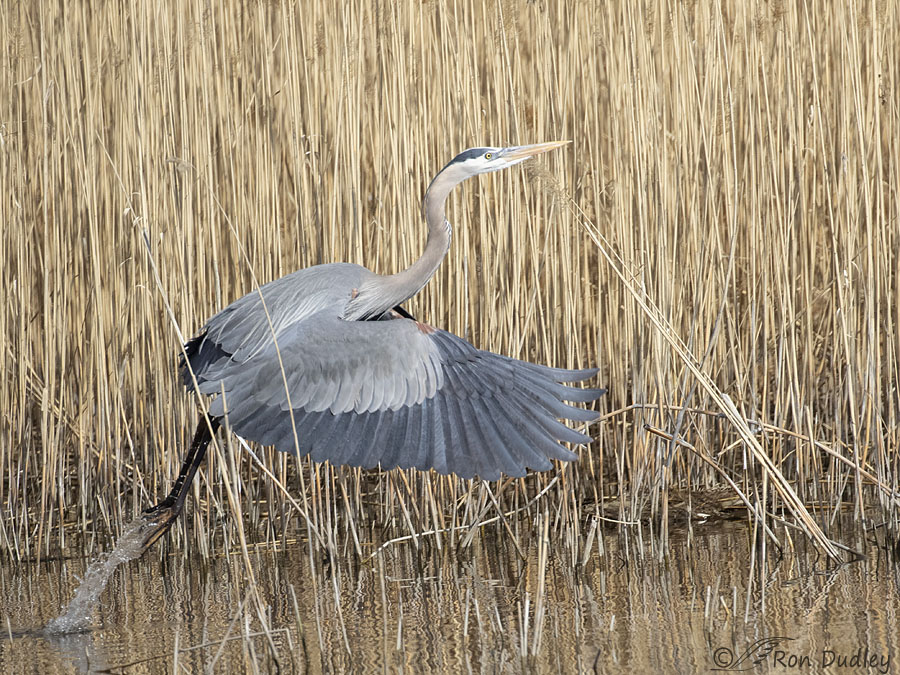
1/5000, f/6.3, ISO 800, Canon 7D Mark II, Canon EF 100-400mm f/4.5-5.6L IS II USM @ 360mm, not baited, set up or called in
Now we see the entire leaning double phrag stem that he’s attempting to avoid with his steep takeoff.
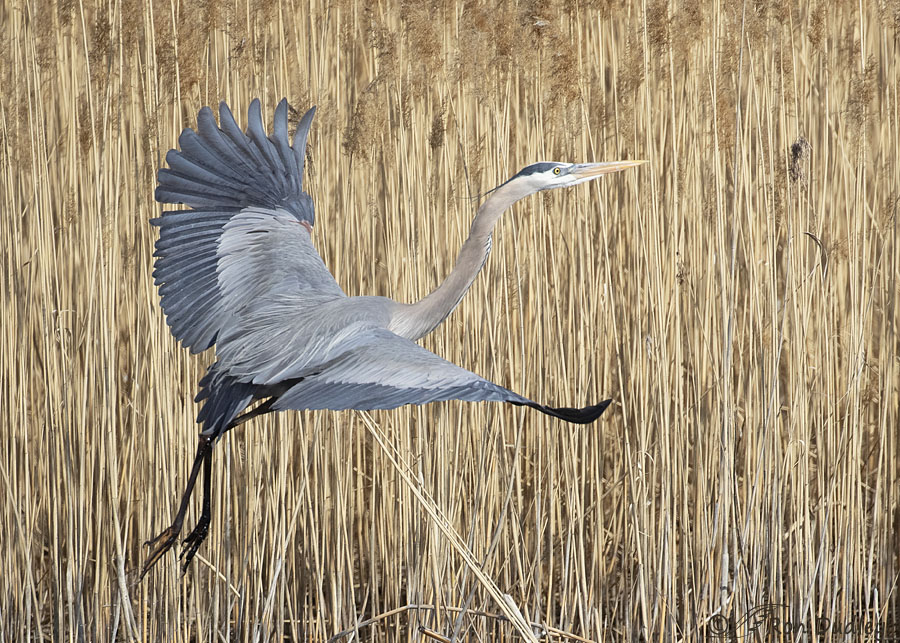
1/5000, f/6.3, ISO 800, Canon 7D Mark II, Canon EF 100-400mm f/4.5-5.6L IS II USM @ 360mm, not baited, set up or called in
Once most of his body had cleared the obstacle he also had to avoid it with his very long legs and feet.
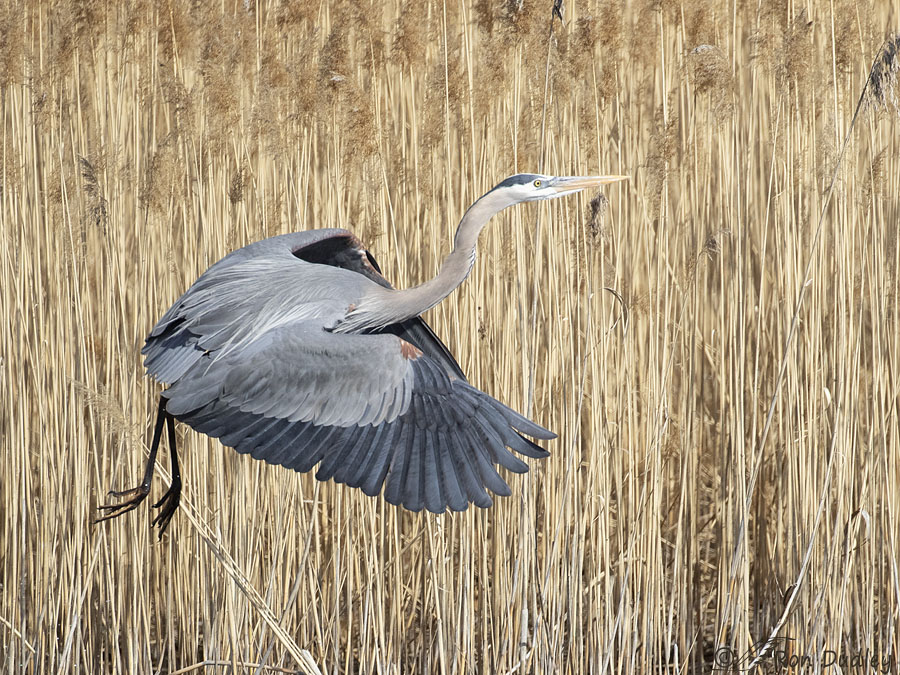
1/5000, f/6.3, ISO 800, Canon 7D Mark II, Canon EF 100-400mm f/4.5-5.6L IS II USM @ 360mm, not baited, set up or called in
But his takeoff angle was steep enough to get it done.
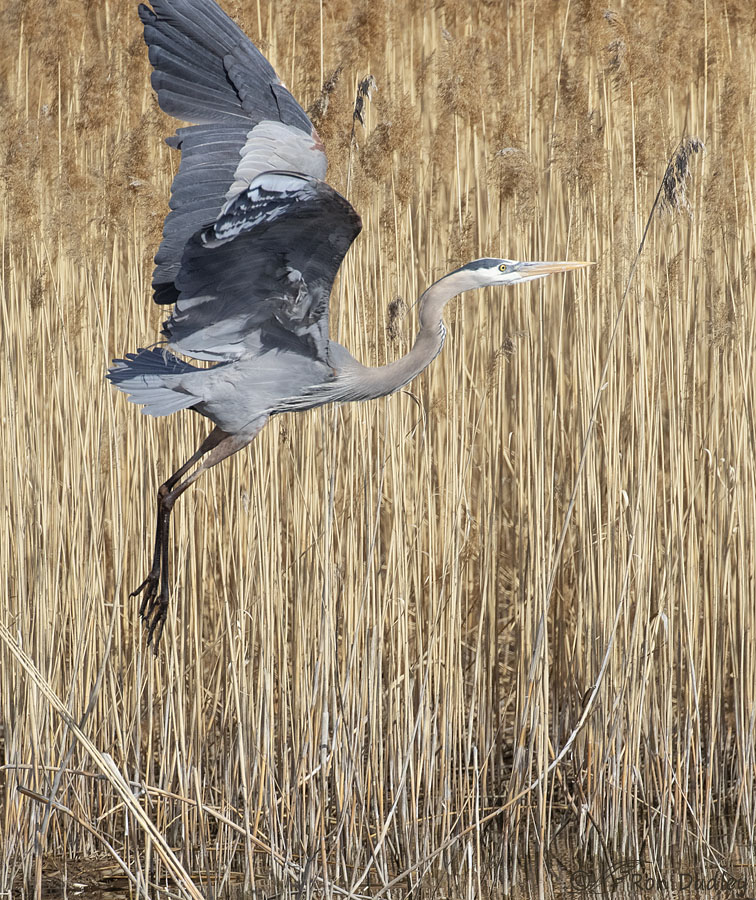
1/5000, f/6.3, ISO 800, Canon 7D Mark II, Canon EF 100-400mm f/4.5-5.6L IS II USM @ 360mm, not baited, set up or called in
In fact it was so steep (for a Great Blue Heron) that even though I thought I had plenty of room in the frame I still clipped a wing in this next photo.
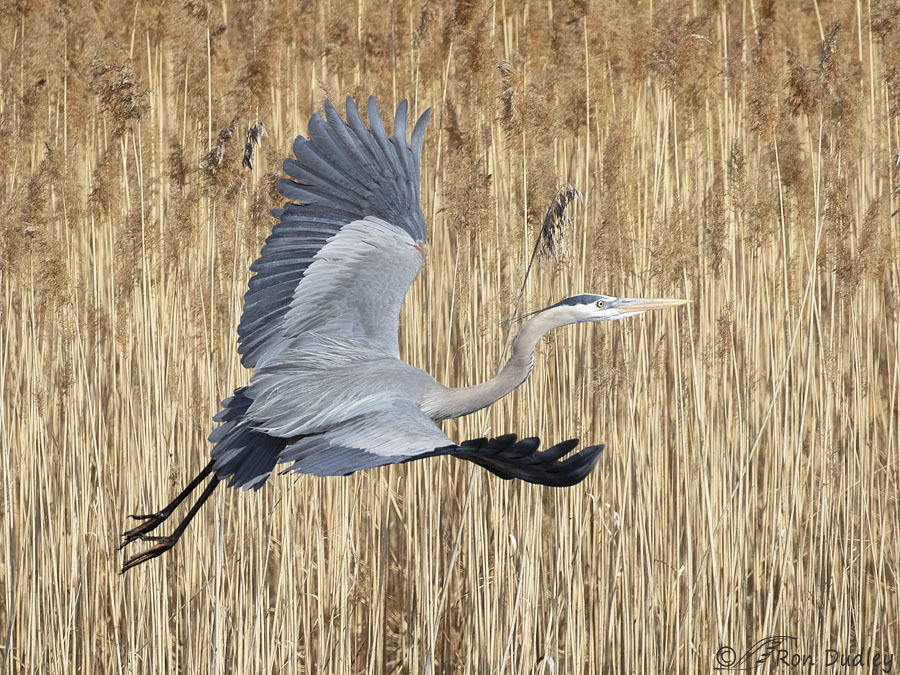
1/6400, f/6.3, ISO 800, Canon 7D Mark II, Canon EF 100-400mm f/4.5-5.6L IS II USM @ 360mm, not baited, set up or called in
Now he’s free and clear and on his way.
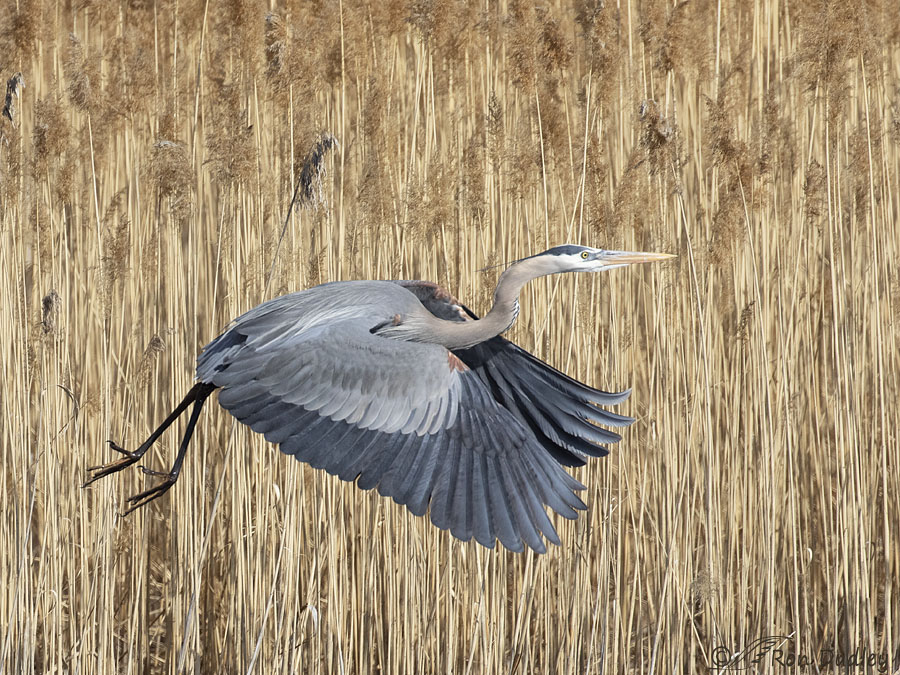
1/6400, f/6.3, ISO 800, Canon 7D Mark II, Canon EF 100-400mm f/4.5-5.6L IS II USM @ 360mm, not baited, set up or called in
At this point his biggest concern was to gain air speed so his long, wide wings were really scooping air.
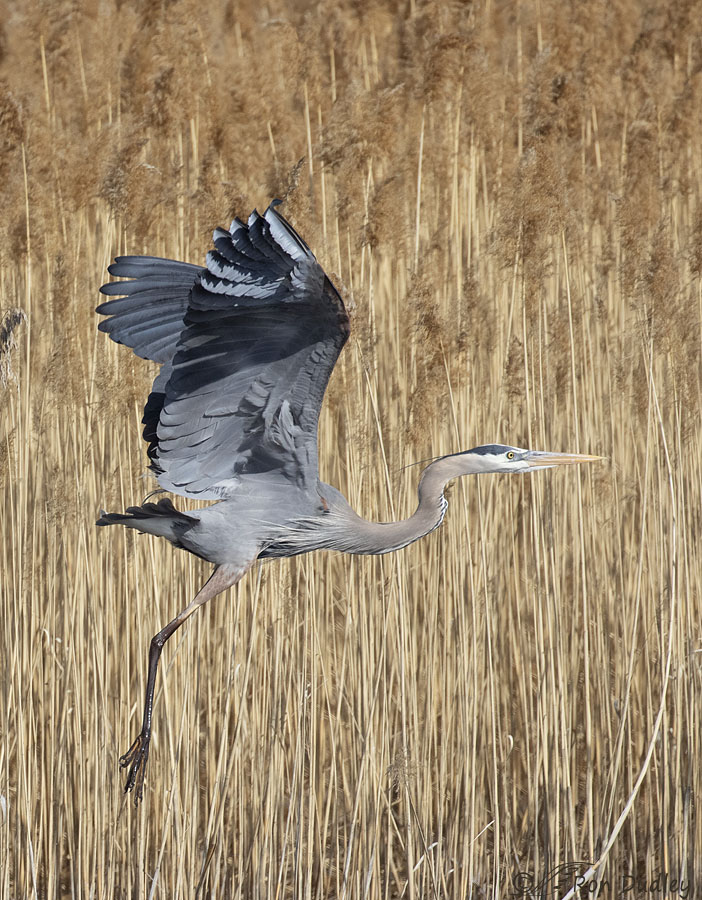
1/6400, f/6.3, ISO 800, Canon 7D Mark II, Canon EF 100-400mm f/4.5-5.6L IS II USM @ 360mm, not baited, set up or called in
After this photo I started to cut off body parts because he’d gained enough air speed to be difficult to track through my viewfinder.
I know, so what? The heron took off more steeply than usual – big deal. But for a bird photographer like me it is a big deal. Knowing typical takeoff and flight patterns of various bird species gives me a better chance to keep them in frame.
But if there’s anything predictable about birds it’s that they’re unpredictable so it’s a work in progress.
Ron


So beautiful, just catching up on the big screen at home!
That big scoop of air! I’ve been startled (or startled it) by a GBH. It was hidden on the bank of the bayou off my mother’s home. I went down to see the sunrise. It was a big WOOSH of air.
Yup, you HEAR it don’t you, Arwen.
Such outrageously gorgeous photos of this exquisite bird! Thanks for capturing them for us to marvel at, Ron….as is consensus I feel sure, you add
so much to my day with these photos…..be well!!
Thanks very much, Karen.
Glorious GBH shots, Ron! Everything about today’s and yesterday’s posts reinforce exactly why Great Blue Herons are in my top 5 (or maybe 3) favorite birds!
To be perfectly honest, I doubt that any of your long-time fans would grouse (see what I did there? ) about back-to-backs or threepeats, etc. Heck, you could post shots of dust or belly button lint and I’d be there — especially if you’ve written a good story to go with the pictures.
) about back-to-backs or threepeats, etc. Heck, you could post shots of dust or belly button lint and I’d be there — especially if you’ve written a good story to go with the pictures. 
I appreciate the confidence you have in me, Marty. But I promise, no belly button lint stories…
What an athlete.
Degree of difficulty has come into my head this morning – difficult for you, and for him.
Yet another stellar series.
Thanks, EC. Yes, I was lucky – in part because I somehow got him sharp in flight with the background very close to him.
And as a PS. I am pretty certain that you could post the same species (and possibly the same bird) for a week or more and I will still find things to awe and delight me. And learn in each and every post too.
Well, since I’ve been out of the loop for a few days, I can’t (and won’t) complain about “repeater birds” … besides, I love GBHs! Such fantastic-looking creatures on the ground in their hunting pose or gliding through the air. But while you (and he) were looking at his clearance for take-off, I was noticing his feet in the 3rd & 4th images. Well, you can barely make out his feet as they begin to rise from the depths in #3, but then look at the water pouring off of them in the 4th! The kind of thing I’ve never seen on the few occasions I’ve watched one of these beauties take off. Well done, all of them, Mr. Dudley. Even the clipped-wing shot, because seeing the wings unfurled and his body exposed are also rare in my experience.
I double-dog swear I did not see Lyle’s comment before I posted mine!
I believe you Chris. I spent quite a bit of time looking at his feet and legs in my photos too. I just forgot to mention them in my post.
I can easily imagine this in an art gallery titled “Great Blue Heron Series 2”. Fine display of breeding plumage. For some reason I’m really taken with the feet, just before they rise from the water and then with water trailing.
On Mars, Ingenuity is doing its vertical take offs; I think the Heron will fly much higher and more gracefully here on earth.
Lyle, I haven’t watched any of the video from Ingenuity. I’ve been meaning too but life keeps getting in the way.
It’s been fascinating, Ron. If you get a chance to see any of it — wow — the notion of flying a craft on another planet — holy smokes!!!!!
Here’s a < 5-minute clip about communication with Ingenuity and the first flight is at the end. https://www.youtube.com/watch?v=_HqZn1BePqM
Thanks for the link, Marty. Absolutely amazing that we can do that.
Gorgeous series! Thanks for the back-to-back, these shots are very different from yesterday. And so interesting! This bird is very athletic!
Thank you, Kathleen.
WOW! You REALLY had a great day with the Great Blue’s! So beautiful except, or course, for the last shot showing that wiry body – VERY functional tho……
So beautiful except, or course, for the last shot showing that wiry body – VERY functional tho……  Don’t think I’ve ever seen a steep take off from one of them.
Don’t think I’ve ever seen a steep take off from one of them.
Yup, it was a GBH day for sure. I don’t remember seeing one take off any steeper than this one did but maybe I have.
Always unpredictable. “I know he thinks I will fly straight out in a gradual lift, but let’s see if I can fool him and go straight up and fast.” “He probably doesn’t even think I can do that.”
Beautiful series Ron. I say outstanding photography. In some of the shots the Heron appears just suspended in air. Back to backs with this kind of photography are most welcome.
Thanks very much, Everett.